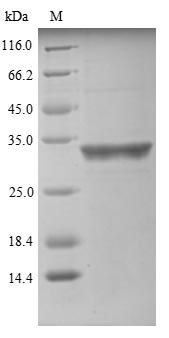Recombinant Human Valacyclovir hydrolase (BPHL) is produced in a yeast expression system, spanning the full length of the mature protein from amino acids 38 to 291. The protein comes with an N-terminal 10xHis-tag and a C-terminal Myc-tag, which makes purification and detection more straightforward. SDS-PAGE analysis indicates purity levels above 90%, suggesting it may be suitable for various research applications.
Valacyclovir hydrolase, also known as BPHL, appears to play a critical role in activating antiviral prodrugs. This enzyme handles the hydrolysis of valacyclovir to its active form, acyclovir—a conversion that seems crucial for therapeutic efficacy. BPHL participates in drug metabolism pathways and has drawn considerable interest in pharmacological research, particularly for optimizing antiviral treatments.
Potential Applications
Note: The applications listed below are based on what we know about this protein's biological functions, published research, and experience from experts in the field. However, we haven't fully tested all of these applications ourselves yet. We'd recommend running some preliminary tests first to make sure they work for your specific research goals.
Based on the provided information, the recombinant BPHL protein cannot be assumed to be correctly folded or bioactive without experimental validation. BPHL is a hydrolytic enzyme that requires precise tertiary structure formation for its catalytic activity, particularly around the active site responsible for valacyclovir hydrolysis. While the yeast expression system provides eukaryotic folding machinery and the protein represents the full-length mature sequence (38-291aa), the dual tagging system (N-terminal 10xHis and C-terminal Myc) presents significant folding risks. Both tags, especially when combined, may cause steric hindrance that disrupts the native protein structure, potentially affecting active site accessibility or dimerization interfaces (if applicable). The C-terminal Myc tag is particularly concerning as it may interfere with proper folding completion. The purity >90% indicates minimal contaminants, but does not guarantee correct folding. Without validation through enzymatic activity assays and structural characterization, the protein's functional status remains uncertain.
1. Enzyme Kinetics and Substrate Specificity Studies
This recombinant BPHL can be used for enzymatic studies only if correct folding and bioactivity are experimentally verified. The dual tags may alter the active site conformation or substrate access, leading to inaccurate kinetic parameters (Km, Vmax). If misfolded, activity measurements would be invalid. It is essential to first confirm hydrolytic activity against valacyclovir using a validated assay before quantitative kinetic studies. Tag removal may be necessary for reliable results.
2. Protein-Protein Interaction Studies
The dual-tagged BPHL can be employed in interaction studies, but detected partners may reflect tag-mediated artifacts rather than biological interactions. The tags (especially the larger 10xHis) may promote non-specific binding or mask authentic interfaces. For valid results, validate folding first and include rigorous controls (e.g., tag-only baits). The Myc tag enables detection but does not ensure native conformation for interactions
3. Antibody Development and Validation
This recombinant BPHL can generate antibodies, but the dual tags may dominate the immune response, resulting in antibodies that primarily recognize tags rather than BPHL-specific epitopes. If misfolded, antibodies may not recognize native BPHL. For specific antibodies, validate using tag-free BPHL or confirm recognition of endogenous protein. The Myc tag serves as a control but does not guarantee BPHL-specific antibody quality.
4. Structural and Biophysical Characterization
The protein is unsuitable for high-resolution structural studies without tag removal, as both tags introduce flexibility and heterogeneity. Biophysical techniques (e.g., circular dichroism) can assess general folding but may be confounded by tag contributions. For meaningful insights, remove tags and validate native-like structure through activity assays first. The yeast expression system supports folding but cannot overcome tag-induced artifacts.
5. Drug Metabolism Research Models
This recombinant BPHL can model drug metabolism only if enzymatic activity is confirmed. The dual tags may alter substrate specificity or catalytic efficiency, leading to misleading metabolism patterns. For reliable prodrug metabolism studies, verify activity with known substrates and consider tag removal. Without validation, results may not reflect physiological enzyme behavior.
Final Recommendation & Action Plan
To ensure reliable outcomes, first validate the folding and bioactivity of the recombinant BPHL through enzymatic activity assays using valacyclovir or a known substrate, coupled with structural analysis (e.g., circular dichroism for secondary structure). Given the potential interference from dual tags, consider tag removal via proteolytic cleavage (if cleavage sites are present) and re-purify the tag-free protein for functional studies. For applications like antibody development, use the current protein but validate resulting antibodies against native BPHL. Always include appropriate controls in experiments, such as tag-free proteins or catalytically inactive mutants, to account for potential artifacts. Priority should be given to enzymatic validation before any quantitative application.






